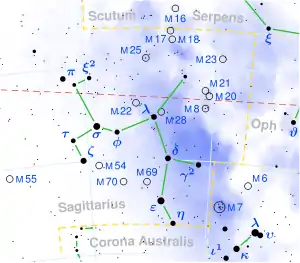HD 165634
HD 165634 is a star in the southern constellation of Sagittarius. It has a yellow hue and is faintly visible to the naked eye with apparent visual magnitude of 4.56.[2] The star is located at a distance of approximately 339 light years from the Sun based on parallax,[1] but is drifting closer with a radial velocity of −5 km/s.[4] It has an absolute magnitude of −0.53.[5]
| Observation data Epoch J2000 Equinox J2000 | |
|---|---|
| Constellation | Sagittarius |
| Right ascension | 18h 08m 04.97982s[1] |
| Declination | −28° 27′ 25.5316″[1] |
| Apparent magnitude (V) | 4.56[2] |
| Characteristics | |
| Spectral type | G7:IIIb CN−1 CH−3.5 HK+1[3] |
| U−B color index | +0.75[2] |
| B−V color index | +0.95[2] |
| Astrometry | |
| Radial velocity (Rv) | −4.87[4] km/s |
| Proper motion (μ) | RA: +25.43[1] mas/yr Dec.: −31.18[1] mas/yr |
| Parallax (π) | 9.62 ± 0.26[1] mas |
| Distance | 339 ± 9 ly (104 ± 3 pc) |
| Absolute magnitude (MV) | −0.53[5] |
| Details[6] | |
| Mass | 3.38 M☉ |
| Radius | 16.98 R☉ |
| Luminosity | 168 L☉ |
| Surface gravity (log g) | 2.51 cgs |
| Temperature | 5,043 K |
| Metallicity [Fe/H] | −0.05 dex |
| Rotational velocity (v sin i) | 2.6[7] km/s |
| Other designations | |
| Database references | |
| SIMBAD | data |
This is a CH-peculiar[9] giant star with a stellar classification of G7:IIIbCN-1CH-3.5HK+1, and has been designated as a standard example of this spectral type.[3] This notation indicates a G-type giant (G7:IIIb) with underabundances of CN and CH molecules. It is a rare "weak G–band star", showing an abnormally weak G band of the molecule CN. This indicates an underabundance of carbon in the stellar atmosphere; the abundances of most other elements are otherwise normal for a star at its evolutionary stage.[10] The depletion of carbon is a reflection of internal processes while the star is on the red giant branch, accompanied by deep mixing.[11]
In 2000, Böhm-Vitense and collaborators suggested that the star has an evolved white dwarf companion. This object can explain an excess flux of ultraviolet radiation, and a mass-transfer could be the source for a mild nitrogen excess on the visible component. The progenitor star was not very evolved because there is no excess of s-process elements such as barium. It may even have been a low-mass star that lost its envelope.[9]
References
- Van Leeuwen, F. (2007). "Validation of the new Hipparcos reduction". Astronomy and Astrophysics. 474 (2): 653. arXiv:0708.1752. Bibcode:2007A&A...474..653V. doi:10.1051/0004-6361:20078357. Vizier catalog entry
- Ducati, J. R. (2002). "Catalogue of Stellar Photometry in Johnson's 11-color system". CDS/ADC Collection of Electronic Catalogues. 2237. Bibcode:2002yCat.2237....0D.
- Keenan, Philip C.; McNeil, Raymond C. (1989). "The Perkins catalog of revised MK types for the cooler stars". The Astrophysical Journal Supplement Series. 71: 245. Bibcode:1989ApJS...71..245K. doi:10.1086/191373.
- Nidever, David L.; et al. (2002). "Radial Velocities for 889 Late-Type Stars". The Astrophysical Journal Supplement Series. 141 (2): 503. arXiv:astro-ph/0112477. Bibcode:2002ApJS..141..503N. doi:10.1086/340570.
- Anderson, E.; Francis, Ch. (2012). "XHIP: An extended hipparcos compilation". Astronomy Letters. 38 (5): 331. arXiv:1108.4971. Bibcode:2012AstL...38..331A. doi:10.1134/S1063773712050015. Vizier catalog entry
- Reffert, Sabine; et al. (2015). "Precise radial velocities of giant stars". Astronomy & Astrophysics. 574: A116. arXiv:1412.4634. Bibcode:2015A&A...574A.116R. doi:10.1051/0004-6361/201322360. hdl:10722/215277. Vizier catalog entry
- De Medeiros, J. R.; Alves, S.; Udry, S.; Andersen, J.; Nordström, B.; Mayor, M. (2014). "A catalog of rotational and radial velocities for evolved stars". Astronomy & Astrophysics. 561: A126. arXiv:1312.3474. Bibcode:2014A&A...561A.126D. doi:10.1051/0004-6361/201220762. Vizier catalog entry
- "HD 165634". SIMBAD. Centre de données astronomiques de Strasbourg. Retrieved 2020-11-29.
- Böhm-Vitense, Erika; et al. (April 2000). "Do All BA II Stars Have White Dwarf Companions?". The Astrophysical Journal. 533 (2): 969–983. Bibcode:2000ApJ...533..969B. doi:10.1086/308678.
- Sneden, C.; et al. (June 1978). "Light-element abundances in the weak G-band star HR 6766". Astrophysical Journal. 222: 585–594. Bibcode:1978ApJ...222..585S. doi:10.1086/156173.
- Palacios, A.; et al. (February 2012). "Weak G-band stars on the H-R diagram: clues to the origin of the Li anomaly". Astronomy & Astrophysics. 538: 11. arXiv:1112.2973. Bibcode:2012A&A...538A..68P. doi:10.1051/0004-6361/201117988. A68.
